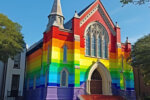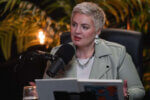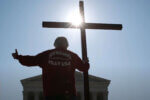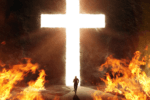Russian Pentecostals poured into the United States before and after the collapse of Soviet communism. Today, they have built a thriving Christian community in the
Pacific Northwest.
Here, they don’t hide in a basement to pray as someone stands guard at the window. Here, they don’t sneak into the forest to worship, or worry about being followed.
Here, in America, the country they once knew only as the enemy, they drive to the church they built with their own hands, squeeze into comfortable pews and worship openly. None of the Russian immigrants who filled the 1,300-seat sanctuary on a recent Sunday morning in Tacoma, Washington, feared being thrown into jail for coming to church.
They are safe at last.
“Now we have freedom to praise God,” said Pavel Kosiuga, one of 11 assistant pastors at the Russian-speaking church. “Freedom to come to church and not be afraid. This is good. Praise God for freedom.”
Kosiuga’s story, like so many of the million Russian immigrants who have come to the United States since the collapse of the Soviet Union, is about finding religious freedom. Kosiuga left a job as an engineer in Odessa, Ukraine, to come to Tacoma in 1990 and today works as a janitor in an Assemblies of God church. And he worships without fear.
“I brought only the clothes I could pack in my suitcase,” Kosiuga said in broken English. “I leave everything. My car. My house. My money. They don’t let me bring my money.”
It didn’t matter.
“Nobody is rich in Russia,” he said. “Everyone middle or poor. Bread, potatoes. That’s it. Life not terribly bad. But no religious freedom.”
Before coming here, Kosiuga received threatening phone calls from the government, warning him not to bring his four children to church. It was against the law to bring anyone under 18 to church.
“They said they’d take my children away,” Kosiuga said.
In Sunday morning services at the Slavic Christian Center where Kosiuga now attends, children sit next to their parents and sing a Russian version of “Jesus Loves Me.” A youth choir accompanied by an accordion player sings Russian songs. A teenage boy dressed in a white shirt and black tie, and a girl wearing a black skirt and white blouse with a challis scarf draped on her head sing a duet. About half of the congregation is under the age of 18. It’s not a crime to bring children to church here.
The new $3.5 million Slavic Christian Center, its green dome and gold-painted cross symbols of its new religious freedom, began with 15 people meeting in a Tacoma apartment in 1989. By 1992, Peter Sayenko, a pastor in Ukraine who drove a truck, became the leader of the little gathering of Russian immigrants. Under his leadership, the church steadily grew, progressing from tiny afternoon meetings in other churches to eventually packing a Salvation Army church that permitted weekly meetings.
Wanting his own church, Sayenko, a bold thinker, began looking for property to build. A Christian contractor put him in contact with U.S. West, a telephone company that wanted to sell a 24,000 square-foot garage that had been empty for 15 years.
The asking price for the five acres of property and worn metal-sided building was $860,000. Sayenko shook his head no, saying, “We’ll pray.”
Sayenko’s counteroffer was $300,000. “They laughed so hard,” said Andrey Ivantsov, who came to Tacoma in 1990 and is an assistant pastor with Sayenko today. “But Peter didn’t laugh. He said, ‘No more.'”
Over the next 18 months, the telephone company lowered its offer several times, dropping nearly $200,000 with each offer. Finally, an agreement was reached.
“We bought it for $290,000,” Kosiuga said. “It was a miracle.”
And it was an agreement of trust. Because Sayenko’s congregation, made up of people from Russia, Ukraine and Moldova, spoke little English when they first arrived, most worked minimum-wage jobs. After paying rent, food and utilities, little was left for tithing, but somehow they managed to remodel this massive garage that became a framework for a church. No bank would give the church a loan.
Understanding that he was operating on a tight budget, Sayenko took a unique approach to fund raising. At the first church service in the converted garage, Sayenko began the remodeling project by asking the congregation of 1,000, “Who is going to buy this door?” Someone’s hand went up. “Who is going to buy this carpet here?” he said. Another hand went up.
Piece by piece, the remodeling was paid for. Volunteers did much of the work. It took almost $800,000 and 18 months to complete the remodeling, turning a worn, abandoned garage into a practical, functional church with classrooms.
But the church was still without a sanctuary. The second phase cost $2.5 million and was built by Absher Construction Co. But this time, Sayenko was able to swing a bank loan because of the equity in the church.
“Here, everyone get loans,” Kosiuga said. “It’s the American way. No one gets loans in Russia.”
In December 2001, this church made of people once scorned by an atheistic government gathered in their new sanctuary. Not one seat was available. Grandmothers wearing dresses with scarves on their heads and fathers wearing suits or black leather coats stood because there were not enough seats. People lined the back and sides of the sanctuary.
“It was a wonderful day,” Sayenko said through an interpreter. “Much praying. Much thanks given.”
The people of this church are no strangers to hardship, which helps explain their determined efforts to build. In Russia, Sayenko met secretly with his congregation, often going into the woods to hold services. Kosiuga’s father was arrested for being a Christian. Everyone here who lived under communist rule has a story of persecution. They know of arrests, of children being taken away, of people being let go from work because of their Christian faith.
Sayenko, warned many times to stop preaching, wouldn’t bend to the pressure. As a result, he was fined, often more than the 150 rubles he made a month as a truck driver.
“They didn’t want you preaching to children,” said the 52-year-old Sayenko, father of 12 children. “Their message was, ‘There is no God.’ They didn’t want you telling children there is a God.”
Now, Sayenko, halfway around the world, continues to preach. He talks of beginning a missionary school, sending people to China and Russia. He talks of buying 40 acres for a summer camp. He talks of starting a school for children. Led by Sayenko’s ambitious plans, the Slavic Christian Center is the largest of the 52 Russian churches in Washington that belong to the Slavic Pentecostal Association. Sayenko’s church has 1,100 adult members and another 1,000 children, making it one of the largest Russian-speaking gatherings in the United States every Sunday morning.
“God has blessed us,” Sayenko said in broken English.
From 1988 to 1993, 300,000 refugees from the former USSR poured into the United States. In the two years before 1988, only 41 refugees from the Soviet Union arrived in the state of Washington. With Soviet communism collapsing and Gorbachev’s policy of glasnost coming into effect, that trickle increased to 100 refugees a month settling in Washington.
The count peaked at 227 a month, so high that ex-Soviets accounted for half of the state’s incoming refugees. The number of refugees arriving each year in the Tacoma area jumped from four in 1987 to 1,067 in 1993. An estimated 30,000 ex-Soviets are now living in Washington.
About 75 percent of those who came were Christian Pentecostals. Because the United States acknowledges that evangelicals were persecuted under the Soviet system, it allowed them to immigrate as religious refugees. The U.S.-set limit of 50,000 religious refugees per year was topped several times. Tacoma became a landing point for Russian immigrants as relatives and friends followed the path of their loved ones.
“You write home, you say come here,” Ivantsov said. “You go where you know someone. You go where you know you could join a Russian community.”
Five years ago, Vitaliy Varvaryak was one of Russia’s promising soccer players, starting on the junior national team at age 16. With hopes of making the Olympic team, Varvaryak supported his mother with the pay he earned as a professional soccer player.
“I wanted to stay in Russia,” said Varvaryak while holding his 12-month-old daughter in the church foyer during a Sunday morning service. “I was making good money. I had dreams.”
But his mother, who earned $10 a month working in a clothes factory, insisted they come to America.
“My mother was right,” said Varvaryak, who now attends a community college and wants to be a paramedic. “There was no future for young people … no future for my daughter. Here there is freedom. Here you can worship as you want.”
Life Center, an Assemblies of God church, has teamed with Sayenko’s church since the arrival of the first Russian family. Elaine Nelson, whose parents are Russian immigrants, became Life Center’s connection to the immigrants simply because she spoke Russian.
She eagerly went to the airport in 1989 to welcome the first Russian family, the Shpaks. Rudolf Shpak, father of five children and an electrician in Russia, kissed the floor as he got off the plane that day.
“He was so happy to be here,” Nelson said. “He was so excited to be in America.”
Shpak, who had lived all his life near the Caspian Sea, spoke no English. Fulton Buntain, pastor of Life Center, found housing for the Shpak family and hired Rudolf as a janitor at the church. He was the first of many Russians Buntain hired. Two years ago, Shpak, now 62, became a U.S. citizen.
“This is my home,” Shpak said. “I’ll not go back.”
“While I’m not surprised by what they’ve done, it is remarkable,” Buntain said. “They’re such hard workers. They’re hard working, committed Christians. And that’s a tough combination to beat.”
In addition to providing a place of worship for the Russian people, Life Center, one of the largest churches in Washington, helped house, furnish and feed the immigrant families. When the Russian sanctuary was completed, Life Center donated pews, plumbing fixtures and other supplies.
“Buntain, the people of Life Center, have been good friends,” Kosiuga said. “They’ve been much help to us. They are like brothers.”
Seven days a week, people fill the Slavic Christian Center, coming for prayer meetings, choir practice, Bible studies or youth-group gatherings. Sunday services last three hours, going from 10 a.m. to 1 p.m. Two-hour evening services begin at 7. During the services, several of the assistant pastors speak,
delivering 10-minute messages. Then Sayenko preaches for an hour, speaking in a traditional, fervent evangelical manner.
Everyone speaks Russian. Occasionally, someone speaks Moldovan. No English is spoken. It’s like stepping into a church in Russia.
With the fall of the atheistic Soviet Union, religious freedom has increased, but Christians still face ridicule. However, the Russian migration to the United States has dropped off dramatically, slowed by the immigration caps here and by improved conditions in Russia.
In Russia under the communist rule, Christians were united by hardships, yet Kosiuga believes that his link to God hasn’t changed. The only difference is the way churches meet.
“People same. God same,” Kosiuga said. “Holy Spirit same. Here or in Russia. But here, you are free. You don’t have to hide. Big freedom. Praise God.”
Gail Wood is a Seattle-based writer and frequent contributor to Charisma.






Leave a Comment
You must be logged in to post a comment.